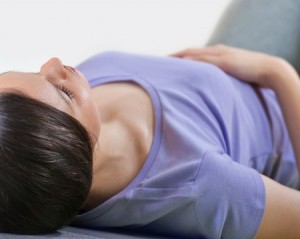Pacing Instructions
Establishing your baseline is the most important part of the pacing structure as it will allow you to understand how your body systems react to the activities you perform daily.
Morning Resting Heart Rate (MRHR) – can be used to illustrate health trends, over time and as a guide to monitor how well activity and rest are being balanced. Be aware: crash day can be marked by a low resting heart rate, so interpret results in light of symptoms and activity history. Both sudden drops and rises in MRHR are a sign of overexertion. If you have not yet got a heart rate monitor, see the bottom of this page for assistance.
Measure MRHR every morning within 15 minutes of waking. Log this so that you can establish a baseline.
Measure resting heart rate following these instructions:
1. Lay down wearing your heart rate monitor
2. Start recording
3. Note the lowest heart rate during that 2 minutes – this is your resting heart rate for that day
4. Record these so that you can easily monitor fluctuations
It is important to:
-Keep the circumstances consistent. Be aware that emotions can cause a shift in heart rate.
-Hydrate (electrolytes if you have orthostatic intolerance e.g. P.O.T.S.).
Recording Heart Rate, Activity and RPE
1. Use a phone app to measure and record MRHR. E.g Polar Beat
2. Record your HR results on an excel spreadsheet
3. Use Apps e.g Log All
4. Log your activity in a daily diary: recording your HR during the activity, your Rate of Perceived Exertion, your body position and if you were over or under your Anaerobic Threshold. Note: if you reach the Yellow Zone of RPE you need to be careful and slow down.
CPET Results & AT
Based on your Cardio Pulmonary Exercise Test (CPET) results, you had your current Anaerobic Threshold (AT) value established. The AT value (which is the VT1 heart rate on your report) is a powerful tool to help you plan your activities of daily living, and through pacing, you will start to take back some control on activities you can do or activities you will have to adapt or postpone. (If you have not had a CPET test you can read more about it here).
Reduce the time spent over the AT and gradually implement the lifestyle changes needed to achieve this outcome. Do small, short term low level activities followed by recovery:
1. Sitting instead of standing e.g. sit in the shower and kitchen
2. Walk up part of the stairs, then sit and recover. Lying on rugs/towels on the floor to reduce HR on the way to the bathroom
3. Use wheelchairs, commodes, pee jars, urinals and any other assistive technology
4. Lying flat in bed rather than resting on the couch
5. Plan your day and prioritise what is most important and adjust activities of daily living:
-Pack groceries strategically with items that needs to be packed away first at the top so that you can leave the rest for later. Or do online shopping that delivers.
-Use a little bag/backpack to bring with you with items you commonly use to reduce the need to use energy to collect these items every time you need them
-Do some activities lying down e.g making your bed while you are in it.
-When cooking, make meals that can be used in more than one meal e.g roast chicken or rice, and plan simple meals with fewer ingredients to reduce time spent in the kitchen.
6. Breaking down activities to ensure you stay in control of your baseline. E.g. If you take 30 minutes to prepare dinner, you can try to do 10 minutes bouts with rest in between first separating what food and equipment you need to prepare your food, then cutting and preparing all ingredients, then cooking.
7. Be aware that emotions can have an impact on your baseline which will add an extra stress in addition to the physical stress. If this happens, still use your cut off HR and adjust to recover. You will also notice that there are times of the day where you may be more capable of doing activities.
If you have orthostatic intolerance, reduce venous pooling by elevating legs and use compression stockings could help reduce brain fog and cardiac stress.
How To Assist Recovery
Lying on your back with your head supported by a pillow. Place your hands over the bottom part of your ribs. Notice where you are breathing. Focus on filling your lungs allowing your lower ribs to expand into your hands, breathing in through your nose. Then breath out through your mouth emptying your lungs of air. Ensure your neck and upper chest is relaxed. Focus on slowing down your breathing.
Meditation can be helpful. You can use guided meditation Apps such as Insight timer and Calm
Do You Need Help?
Our exercise physiologist is happy to guide you to assist in better pacing and monitoring. Please contact Physiologic (55787155 or email admin@physiologic.com.au) asking for an appointment with Emerson. Skype appointments and weekly email communication is available.
Selecting Heart Rate Monitor
Ideally one with a chest strap as these are most accurate in recording your heart rate (we recommend Polar). However, you need to find a monitor that you are comfortable using, that suits your budget and that you are likely to use. If you rather use a wrist based monitor then that is better than nothing, however keep in mind this is less accurate than the monitors with the chest strap. Tips when using chest strap; ensure that the electrodes are well connected to your skin. Electrode gel will help improve the connection.
